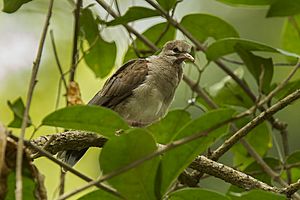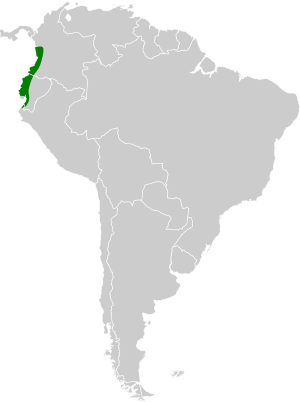Pallid dove facts for kids
Quick facts for kids Pallid dove |
|
|---|---|
 |
|
| Conservation status | |
| Scientific classification | |
| Genus: |
Leptotila
|
| Species: |
pallida
|
 |
|
The pallid dove (scientific name: Leptotila pallida) is a type of bird that belongs to the Columbidae family, which includes doves and pigeons. You can find this bird living in parts of Colombia, Ecuador, and Peru.
Contents
About the Pallid Dove
What Makes the Pallid Dove Special?
The pallid dove is a unique bird. It is considered monotypic, which means it is the only species in its group. For a while, scientists thought the pallid dove might be the same species as other doves, like the grey-fronted dove or the grey-headed dove. However, they are now recognized as separate species.
What Does the Pallid Dove Look Like?
The pallid dove is a medium-sized bird, about 23 to 26 centimeters (9 to 10 inches) long. It has some very distinct features!
Male Pallid Dove Features
- Head and Neck: Males have a white forehead, face, and throat. Their crown is gray, and the back of their neck (nape) is a pretty purplish-gray.
- Body Colors: The sides of their neck and chest are a pale red, while their belly is white.
- Upperparts: Their back and wings are a chestnut-brown color, sometimes with reddish markings. The back of their neck can even have a shiny purple look!
- Tail: The outer feathers of their tail are dark chestnut with white tips.
- Eyes and Beak: They have yellow eyes surrounded by bare red skin. Their beak is black, and their legs and feet are pinkish-red.
Female Pallid Dove Features
Female pallid doves look similar to males but are a bit duller. Their upperparts are less reddish, and their pink and gray areas are not as bright.
Where Does the Pallid Dove Live?
The pallid dove lives in the warm, tropical lowlands of western South America. You can find them from the Chocó Department in west-central Colombia, all the way through Ecuador, and into the far northwestern part of Peru, in a place called the Department of Tumbes.
Pallid Dove Habitat
This bird prefers to live in the Pacific/Chocó natural region, which is known for its special plants and animals. They live in both untouched tropical evergreen forests and forests that are regrowing after being disturbed. They also like drier, semi-deciduous woodlands, where some trees lose their leaves. You can find them from sea level up to about 800 meters (2,600 feet) high.
How Does the Pallid Dove Behave?
Feeding Habits
Pallid doves are usually seen alone or in pairs. Scientists don't know much about what they eat or how they find their food. However, they have been seen looking for food on the ground. They have also been recorded eating bananas at bird feeders!
Reproduction and Life Cycle
We know very little about how pallid doves raise their young or their breeding habits. More research is needed to understand their life cycle better.
What Does the Pallid Dove Sound Like?
The song of the pallid dove is quite sad and simple. It's described as "a single mournful monotonous note 'wooOOOoo' which fades in and out." Their song is very similar to that of the grey-fronted dove.
Is the Pallid Dove in Danger?
The IUCN (International Union for Conservation of Nature) has looked at the pallid dove's situation. They have assessed it as being of "Least Concern." This means that the species is not currently considered to be in danger of disappearing.
Why is it "Least Concern"?
- Wide Range: It lives across a fairly large area.
- Common in Areas: People have reported that it is common in many places where it lives.
- Protected Areas: It can be found in several areas that are protected by conservation efforts.
Even though it's not in danger, scientists still don't know a lot about its biology and how it lives in its environment. More studies would help us understand and protect this interesting bird even better!
See also
 In Spanish: Paloma montaraz pálida para niños
In Spanish: Paloma montaraz pálida para niños


